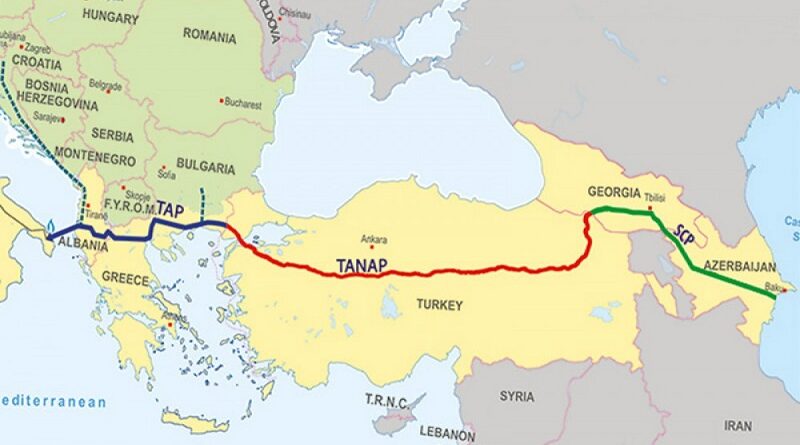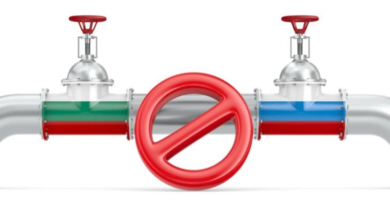The Southern Gas Corridor and its impact on gas diversification in SEE – a reality check
The EU touted the Southern Gas Corridor (SGC) as the epitome of what EU joint action and prioritization of energy security could deliver to diversify gas dependence on Russia and give Southeast Europe a much-needed alternative. Accordingly, the TAP pipeline was entrusted with an unprecedented political, financial and institutional support by both the EU and the United States, in hopes that countries in the region could have some leverage versus Gazprom. The Azeri natural gas started flowing via the new route – TAP in January 1st, 2021. So the timing, at least in theory, was perfect – before the renewal of the long-term gas supply contracts with Gazprom.
The Supply Side
According to official data from Baku, by the end of October 2021, more than 4,6 bcm of Azeri gas have been shipped via TAP to Italy, Greece and Bulgaria. Of this total volume, Italy accounted for 3.9 billion cubic meters worth $1.2 billion, Greece took 501.7 million cubic meters, paying $163.7 million and finally Bulgaria bought 166 million cubic meters for $25.5 million.
If we try to gauge the Azeri gas’s diversification effect on the Southeast European gas market, it is meager to none. And there is a story behind. By picking TAP over Nabucco, the Shah Deniz 2 consortium, led by BP, diverted the diversification impact away from the CEE region to Italy, reflecting Moscow’s desire to disallow competing gas from a market it dominates for political gains. The Shah Deniz Consortium chose the Italian market and the adjacent gas hubs instead of Ukraine or the other CEE countries where the diversification and geopolitical impact would be much stronger. Eighty per cent of the gas flow via the TAP or 8 BCM is supposed to bypass the SEE and CEE region, contracted by Axpo Trading AG, Enel Trade SpA, E.ON Global Commodities SE, Gas Natural Aprovisionamientos SDG SA, GDF SUEZ SA, Hera Trading SRL and Shell Energy Europe Limited. Only 2 BCM were contracted by the Greek and Bulgarian state gas traders – DEPA and Bulgargaz, with marginal effect on competion in the region.
Out of 4,6 BCM really transported by the TAP in the first 10 months of 2021, only 667 MCM remained in Greece and Bulgaria, less than 14,5 per cent of the total volume and below the due share. Moreover, while Greece took its ten per cent proportionate part, Bulgaria took just one-third of what it was entitled to, nullifying the Azeri gas direct and indirect diversification effect for the SEE and CEE.
In the meantime, instead of losing shares, Gazprom increased its supplies to Bulgaria (+48.2 per cent), to Turkey (+98.1 per cent), Romania (+247.1 per cent), Serbia (+92.9 per cent), Greece (+13.7 per cent) – all countries within reach of the SGC. While in the 2019-2020 gas year, Gazprom’s share in the Bulgarian gas market dropped to 80 per cent, at the end of 2021 it is hovering again above 92 per cent. In Romania Gazprom gas imports peaked in 2021 and remained monopoly high in Serbia.
These articles analyses and comments are made possible thanks to your empathy and contributions, which are the only guarantors of independence and objectivity in our work. The Alternatives and Analysis team.
In short, in the first year of operation of the TAP and the SGC, the Azeri gas did not yield any tangible diversification effect, despite offering more competitive prices. And the forecast for 2022 is not any better.
Due to the sky-rocketing hub prices, LNG’s share in the regional gas market shrunk. Even in Turkey, which last year marked the second highest LNG import volumes in Europe, its share dropped from 30 in 2020, to 20 per cent in 2021.
The physical availability and price competitiveness of Azeri gas (3-7 times lower) did not prove sufficient to undermine Gazprom’s monopoly.
Why is that so?
To start with – the legacy of the Nabucco vs TAP dilemma and the selection of the route to Italy.
Gazprom’s and Russia’s used their geopolitical leverage at governmental and corporate level in the EU, at the Shah Deniz consortium and its leader BP, the governments of Azerbaidjan and Bulgaria to make sure Azeri gas does not flow north of the SGC in high volumes and compete in the CEE gas market.
For once, Gazprom is profiting in full from the legacy of LTC contracts to shape the preferences and spread its corruption net across the political and business establishment in Southeast Europe.
Moreover, by successfully containing the diversification potential of the SGC, Gazprom guarantees itself an exclusive status before it renews its long-term gas supply contracts in 2022 and 2023 in the region. More importantly, Russian gas faces little competition from existing suppliers in new gas demand generated by coal-to-gas conversion projects in the region.
Russian gas could look down on LNG spot traders not only due to astronomically high hub prices, destroying demand, or passage restrictions at the Turkish Straits but due to transmission capacity control on essential exit/entry transit routes via Bulgaria to RNM, Serbia and Romania.
Unable to assess and mitigate the political risk in a business and political environment in the grip of Gazprom, most LNG traders are unwilling to deliver gas to customers in the SEE, offering instead to ship LNG cargoes to terminals in Greece and Turkey.
Existing LNG terminals in Turkey are not an option until a network agreement between Bulgartransgaz and Botas is in place, which in all likelihood is not going to happen before the new LTCs with Gazprom are signed.
Reducing Gazprom’s share of the regional gas market (Bulgaria, Serbia, Greece, Romania and North Macedonia) by only 30 per cent would imply an up-for-grabs demand of 4-5 BCM. However, such quantities are not immediately identifiable on the radar – certainly not from Azerbaidjan (until 2025) or soon from LNG, in time to present a credible challenge to the closure of the LTCs with Gazprom in 2022 and more importantly to cover peak demand after UGS are substantially depleted after February 2022.
The Southern Gas Corridor, in its present modus operandi, is bound to have a marginal effect on gas diversification in SEE and CEE. Against the backdrop of the Turk Stream coming online and Gazrpom’s reach in the region the EU has little to celebrate.
Ilian Vassilev
Thank you for your donations via PayPal and bank transfers to IBAN BG58UBBS80021090022940




